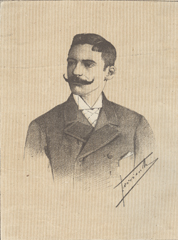3.1.2 The cultivation of poetry by Enrique Hernández Miyares (1859 – 1914)

Enrique Hernández Miyares was more of a cultural promoter than a poet, but this does not mean that his work lacked some aesthetic value, although he did not really explore the essence of poetry extensively. José Lezama Lima includes him in the modernist orbit, but his lyrical career and his own demeanor were characterized by classical reminiscences, combined with a certain romantic tone, so his poetics are not entirely in tune with modernism.
The work that, in a sense, launched him to fame was “La más fermosa,” published in 1903 in “El Mundo.” He had already published texts in colonial-era newspapers during the period of the independence struggle, a period during which he matured as a writer. The sonnet, classified as one of the most accomplished in our tradition, led to the malicious accusation of plagiarizing the poet Francisco Rodríguez Marín, which was denied even by the latter. The following is a transcript of this piece:
“Let the knight go his way”
Undoing wrongs with his spear:
All noble tenacity eventually achieves
Establish the just laws of destiny.
Put on Mambrino’s broken helmet
And on your glorious, haughty nag you advance,
Sancho Panza ignores the sayings
And trust in your arm and in your destiny.
Do not fear the elusiveness of fortune:
If the Knight of the White Moon
Measure your weapons against theirs, dare.
And knocks you down by contrary luck,
of Dulcinea, yearning for your death,
“Say that she will always be the most beautiful!”
This sonnet has few foundations in the national lyrical tradition, both in its topic and tone, and it fits into the best of the cultivation of an apologetic tendency in Hispanic poetry that continued to prevail with few successes even at the dawn of the 20th century.
The poem’s message, quite explicit, contradicts the ontological pessimism of modernism, and therefore does not subscribe to it. This calls into question Enrique Hernández Miyares’s modernist status, unless broader foundations are given to what is usually classified as modernism.
He would dedicate this poem to Manuel Sanguily, he conceived another after the death of Rafael Montoro and a heartfelt song with an elegiac tone in memory of Julián del Casal, of whom he was a close friend, in which he mourns the passing of the great poet and confesses that he still imagines that he has not died.
He also wrote the poem “Carmen,” which recreates the theme of the famous opera by French composer Georges Bizet, but whose underlying theme and lyrical treatment by Enrique Hernández Miyares are very akin to Spanish sensuality. This and the rest of his poetic works were published posthumously in 1919, in an edition published by the National Academy of Arts and Letters.
He also wrote two poems with a pro-independence theme, centered around the symbol of the machete. In this vein, he also wrote the sonnet “Dos banderas,” similar to Bonifacio Byrne’s “Mi bandera” (My Flag); although with a more ambiguous approach regarding Cuba’s relations with the United States, something almost unknown in our poetry, a regrettable fact as it illustrates the emotional landscape surrounding the American occupation:
“The morning sun shines brightly
And on the gray wall of a rooftop
The Cuban flag waves in the air
Attached to the American flag.
Together the two, their symbolism is a sister
The idea of sacrosanct freedom;
Deployed yesterday in the fight
They folded the Spanish flag.
One and the other, like a herald of joy,
Stars and colors give to the wind
That with gallant breath the tremola:
May destiny always keep you friends.
Despite perfidious intrigues…
But let them never form one!








